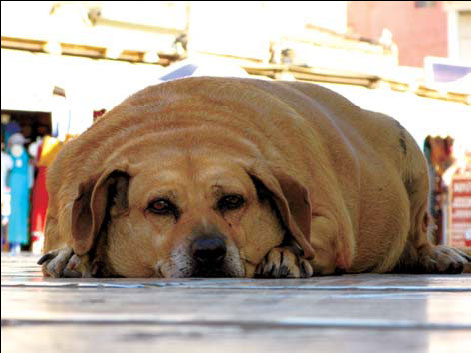Take it easy with those dog treats
By Aliki Nassoufis (China Daily)
Updated: 2010-06-01 09:48
 |
Large Medium Small |

The prevalence of treats for dogs has led to the growing issue of canine obesity.
Being overweight is not only an aesthetic problem for your pet, it is also a serious health matter that will make your four-legged friend pant at the slightest movement and leave it exhausted.
However, there are a few things a dog owner can do to get their animal looking slim and sleek again.
Dogs grow fat for similar reasons to humans: "The amount of energy they consume is greater than what they expend," says Professor Juergen Zentek from the Institute for Animal Diet at the Free University in Berlin.
In some cases there can be a medical explanation such as an under-active thyroid gland. Elderly dogs, castrated animals and some breeds such as the Pug or Cocker Spaniel also tend to become overweight.
Obesity always poses health problems for a pet. "Obesity-related illness in animals are like those of humans," says Zentek. "They include joint problems, cardiovascular disease, diabetes and hormone imbalances."
There are a few rules of thumb to help you find out whether your pet is overweight. "Their ribs should not be visible but you should be able to feel them," explains dog nutritionist Anke Trobisch. "And when you look down at them you should be able to clearly see a small waistline."
One method to get your dog to shed weight is to feed them less. "But some dogs won't play along with that," warns Zentek. "They may start to beg, rob garbage or even become aggressive."
For that reason it is very important to choose the right food to feed your pet. "You should first find out what ingredients have been put into the food," advises animal psychologist Marcel Hein. "If it contains sugar and too much fat, then you shouldn't buy it."
"A dog owner should feed their pet small meals several times over the course of the day and make sure they don't give their dog too many treats," advises Trobisch.
Physical exercise plays a central role in getting your pet to lose weight. "Walking around the block is different from getting your dog to walk beside you as you cycle a bike for a long distance," says Hein.
Mantrailing, where your dog searches for a person, is a great way to provide your pet with an all-round exercise program. Hein says it also helps you build a relationship with your dog and is good exercise for humans too.
A dog owner should also take care to make sure their pet gets the right amount of exercise. "That depends on the breed of dog and if it is physically handicapped in any way," says Hein. "How fit is the animal? How old? Are there any health issues such as joint problems or damage to the pelvis?"
It is also a good idea to consult with your vet before beginning a slimming program. "The dog should lose weight permanently and not regain it. Weight should be shed at no more than the rate of one per cent of the animal's body mass per week," says Zentek.
But better than any diet plan is to prevent your dog from getting fat in the first place. "The dog has no choice in the matter," says Hein. "The responsibility rests on our shoulders."